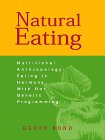Everything we know about our prehistoric ancestors is that they were lean. Everything we know about our biology today is that to be overweight is unhealthy.
For our ancestors, food bonanzas were rare. Most of the time they were slightly hungry. We can imagine why. Getting food required work. They did the minimum work necessary for survival. If they finished lunch hungry, they had a choice. Go off for an hour or two and find more food or have a siesta during the heat of the day. There was thus an automatic mechanism controlling the intake of food. You had to really want the food to go to the effort of getting it.
Humans, unlike some creatures, were not living surrounded by their food. We do not have a well-developed satiety reflex. That is to say; our bodies do not have strong signals telling us to stop eating. That never had to be programmed into us in our Pleistocene past. On the contrary, we have a reflex that tells us to keep eating for as long as there is food around.
Today of course, in the affluent countries, we are surrounded by food. We can, with no effort, satisfy our desire for food. Today, we need to exercise self-discipline. Fortunately, that self discipline can be exercised not so much on the amount we eat but on what we eat.
How much weight is excess? There is a rule of thumb known as the Body Mass Index (BMI). It is calculated as your weight (in kg) divided by your height (in metres) squared. The same figures applies to both men and women.
Really lean hunter/gatherer societies like the Australian Aborigines or the Bushmen of the Kalahari have BMIs in the range 13 to 19. These peoples have low blood pressure, no heart disease or diabetes, and no cancer.
This seemingly is the ideal. An ideal that is hopelessly out of reach of the average Westerner. Fortunately it is not necessary to reach these very low figures for BMI. The studies show, and modern medical wisdom has accepted, that BMI's in the range 20 to 25 are fine for optimum health. BMI's of 25 to 30 are 'overweight', and already adverse health consequences are setting in. 30 to 35 is 'obese', Over 35 is 'grossly obese'. With increasing levels of obesity, so the health consequences are the more grave.
This table gives some typical values of BMI.
|
Body Mass Index and Weight |
|||
|
Healthy |
Overweight |
Obese |
|
|
BMI Height 5'-3" 5'-8" 6'-0" |
20 to 25 wt. - lb. 113 to 141 131 to 164 147 to 184 |
25 to 30 wt. - lb. 142 to 169 165 to 197 183 to 221 |
30 to 35 wt. - lb. 170 to 197 198 to 230 222 to 258 |
What can be done about being overweight? Live like an Australian Aborigine! All right, in the real world that is not possible, so what are the strategies that we can employ?
'Fat makes you fat'. That is true, but that is not the whole story. If it were, Americans, who are paranoid about fat, would be the slimmest people on earth. Instead, in spite of the 20 year drive against fat in the diet, Americans are fatter than ever!
No, there is a second factor, bad carbohydrates. Sugars, pastries, breakfast cereals, breads, pastas and potatoes are the new villains of the piece. Indeed as fast as manufacturers have taken fats out of their products, so they have added sugars and other bad carbohydrates. The manufacturers are driven by sales, and what the public will buy is foodstuffs that are tasty. And sugars are cheap and easy taste enhancers.
It is up to you, the public, to be more discerning. Read the small print on all the food labels. Ruthlessly exclude fats and bad carbohydrates.
Finally, there are the bad food combinations, especially starch/fat and starch/protein. Why are they so bad? Starch increases the level of insulin in the blood, and insulin is the fat storage hormone. Eat fat at the same time as starch, and insulin will obligingly put the fat on the fast track into your fat cells. Bread and butter, french fries and potato chips are very fattening combinations.
What about the protein? Here there is a double whammy. First, the protein magnifies the starch's effect on insulin production so more of this pesky hormone is there to do its storing work. Second, there is always fat associated with protein. No meat, no fish, no cheese, no egg, is without an accompanying cargo of fat. Even most vegetable proteins (nuts, peanut, soy-bean, garbanzo) are not exempt. So, dishes that mix both protein and starch are very fattening combinations. Examples are: hamburgers (bread and beef), pizzas (pastry and cheese), steak and fries ( potato and beef), Spanish omelette (potato and egg).
What if you separate them out? It is better to eat the cheese first then the baguette two hours later than to eat two cheese subs at two hours interval.
In both options, the same amount of food is eaten. In the first case, your insulin levels will have stayed low. There is nothing therefore to encourage the fat in the cheese to be stored in your fat cells. With a bit of luck the fat will be excreted unabsorbed.
But in the second case (the conventional one) the starch in the cheese sub will be levering the fat in the cheese into the fat cells each time you eat it at two hour intervals.
What about alcohol? Rightly, slimmers should be wary of alcoholic drinks and there are three reasons why:
-
Alcohol interferes with the processes that instruct the fat cells to release their stores into the blood-stream. This is another example of how what we put into our mouths can disrupt body bio-chemistry.
-
Alcohol is empty calories.
-
Many alcoholic beverages also contain sugar. The sugar is empty calories too, but worse, sugar is a bad carbohydrate. It is the sugars in beverages like beer and liqueurs that cause them to be so fattening. Dry wine drinkers are much less vulnerable.
This table gives values of sugar content and total calories for a selection of alcoholic drinks. For comparison, figures for two carbonated beverages are also shown.
| Beverage | drink size | amount | calories | sugar |
| Sweet and Alcoholic | ||||
|
beer wine, sweet liqueur |
bottle/can glass jigger |
12 oz. 3 1/2 oz. 1 1/2 oz. |
146 158 186 |
13g 12g 21g |
|
Dry and Alcoholic |
||||
|
wine, dry, white spirit |
glass jigger |
3 1/2 oz. 1 1/2 oz. |
70 97 |
1g 0g |
|
Sweet, non-Alcoholic |
||||
|
tonic water cola |
can can |
12 oz. 12 oz. |
114 150 |
29g 35g |
Referring to the table, the "sweet and alcoholic" drinks are much more fattening than the "dry and alcoholic'' drinks, and it's not just a question of calories, although that is important. The main culprit is the disruption to blood glucose mechanism caused by the sugar content.
The sugar content of various carbonated beverages is now common knowledge. Even so it is salutary to see how just one drink of cola contains 7 teaspoons of sugar. And of course, if they are mixed with spirits (a gin and tonic, for example) then the fattening effect of both drinks is multiplied.
In summary, focus your efforts on eating in accordance with the Natural Eating precepts. Don't worry about how much you are eating. Weight loss will take care of itself.
 This article was excerpted from the book:
This article was excerpted from the book:
Natural Eating
by Geoff Bond. ©2000.
Reprinted with permission from the publisher, Griffin Publishing Group, www.griffinpublishing.com
Info/Order book.
 About The Author
About The Author
Geoff Bond has degrees in pure and applied sciences from London University in the 1960's. In the 70's and 80's Geoff spent many years living amongst peoples in remote parts of the third world. It was there that he deepened his understanding of human origins and Pleistocene eating patterns. This unique, 30 year course of independent study of "Nutritional Anthropology", has led to the development of the Natural Eating philosophy, based only on the most rigorous of scientific research. Visit his website at http://naturaleater.com/ or contact him at
























